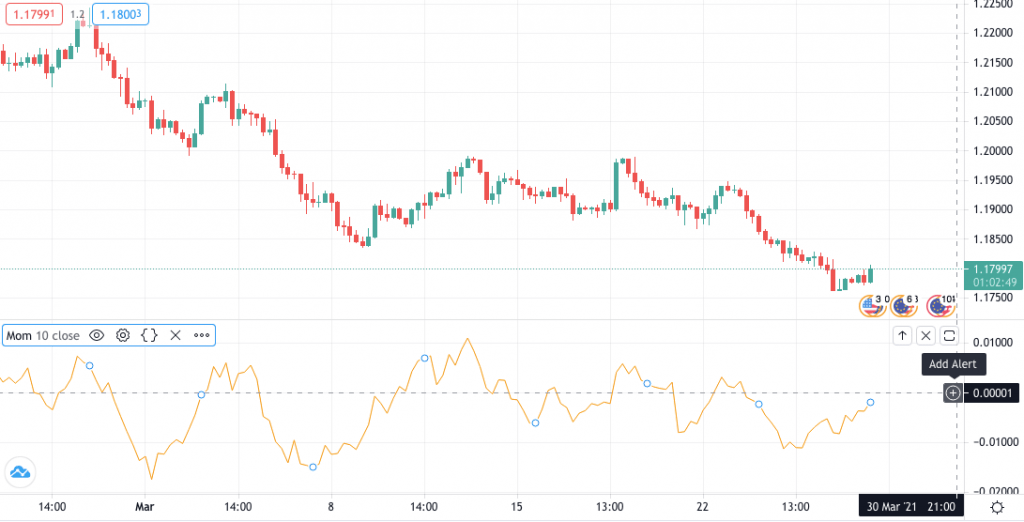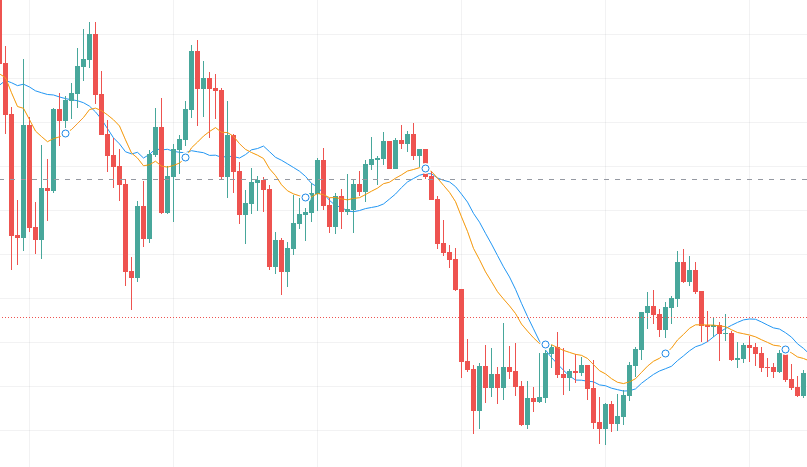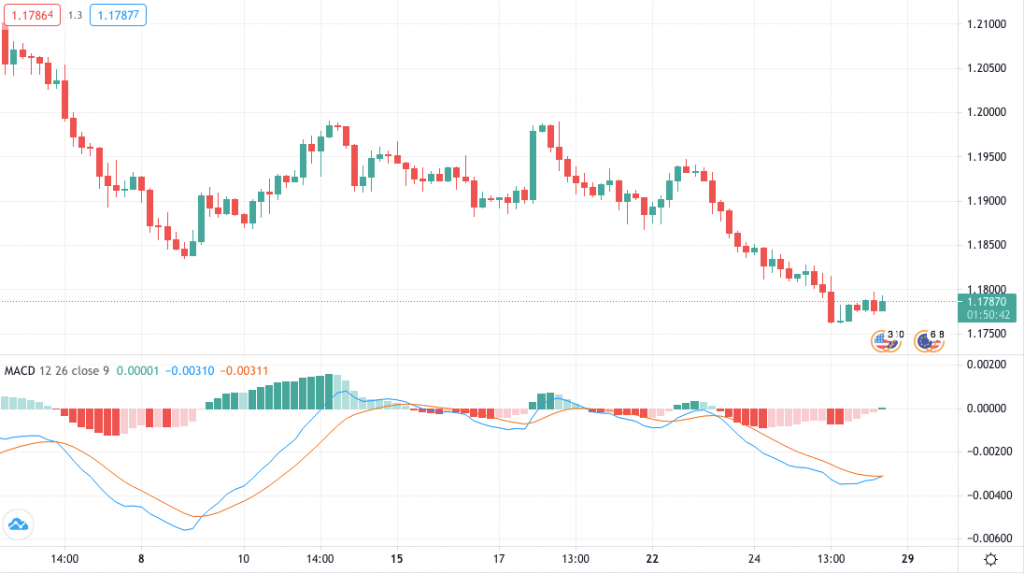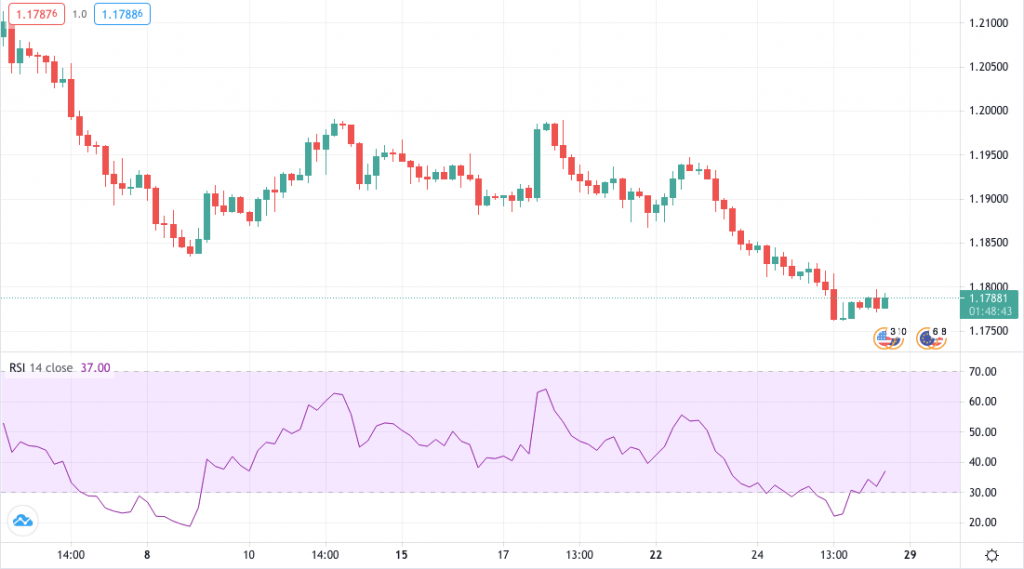Momentum Trading
The momentum trading strategy allows individuals to capitalise on accelerating prices of securities, including forex and stocks. If you’re keen to learn how to day trade using momentum, this article explores some key trading strategies for beginners and experts, as well as top software, indicators and tools. We also discuss some comparisons between momentum trading vs swing trading, trend following, and other popular methods.
Momentum Trading Brokers
-
Founded in Australia in 2010, Pepperstone is a highly regarded broker specialising in forex and CFDs. Serving more than 400,000 clients globally, it provides access to over 1,300 financial instruments through popular platforms like MT4, MT5, cTrader, and TradingView. Its fee structure is both low and transparent. With regulation by reputable bodies such as the FCA, ASIC, and CySEC, Pepperstone guarantees a safe trading environment for traders at every level.
Instruments Regulator Platforms CFDs, Forex, Currency Indices, Stocks, Indices, Commodities, ETFs, Crypto (only Pro clients), Spread Betting FCA, ASIC, CySEC, DFSA, CMA, BaFin, SCB MT4, MT5, cTrader, TradingView, AutoChartist, DupliTrade, Quantower Min. Deposit Min. Trade Leverage $0 0.01 Lots 1:30 (Retail), 1:500 (Pro) -
Established in Poland in 2002, XTB caters to over a million clients worldwide. This forex and CFD broker offers a robust regulatory framework, a diverse range of assets, and prioritises trader satisfaction. It provides an intuitive proprietary platform equipped with excellent tools to support aspiring traders.
Instruments Regulator Platforms CFDs on shares, Indices, ETFs, Raw Materials, Forex currencies, cryptocurrencies, Real shares, Real ETFs FCA, CySEC, KNF, DFSA, FSC xStation Min. Deposit Min. Trade Leverage $0 0.01 Lots 1:30 -
FXCC, a well-established brokerage since 2010, offers cost-effective online trading. Registered in Nevis and regulated by CySEC, it is distinguished by its ECN conditions and absence of a minimum deposit requirement. The account opening process is efficient, taking under five minutes.
Instruments Regulator Platforms CFDs, Forex, Indices, Commodities, Crypto CySEC MT4, MT5 Min. Deposit Min. Trade Leverage $0 0.01 Lots 1:500 -
IC Markets is an internationally acclaimed forex and CFD broker, admired for its competitive pricing, diverse trading instruments, and superior technology. Established in 2007 and based in Australia, the firm is under the regulation of ASIC, CySEC, and FSA. It has successfully drawn over 180,000 clients from more than 200 nations.
Instruments Regulator Platforms CFDs, Forex, Stocks, Indices, Commodities, Bonds, Futures, Crypto ASIC, CySEC, CMA, FSA MT4, MT5, cTrader, TradingView, TradingCentral, DupliTrade, Quantower Min. Deposit Min. Trade Leverage $200 0.01 Lots 1:30 (ASIC & CySEC), 1:500 (FSA), 1:1000 (Global) -
Interactive Brokers (IBKR), a leading brokerage, offers access to 150 markets across 33 countries and provides extensive investment services. With more than 40 years of experience, this Nasdaq-listed company complies with strict regulations from the SEC, FCA, CIRO, and SFC. It is among the most reliable brokers worldwide for traders.
Instruments Regulator Platforms Stocks, Options, Futures, Forex, Funds, Bonds, ETFs, Mutual Funds, CFDs, Cryptocurrencies FCA, SEC, FINRA, CFTC, CBI, CIRO, SFC, MAS, MNB, FINMA, AFM Trader Workstation (TWS), IBKR Desktop, GlobalTrader, Mobile, Client Portal, AlgoTrader, OmniTrader, TradingView, eSignal, TradingCentral, ProRealTime, Quantower Min. Deposit Min. Trade Leverage $0 $100 1:50 -
IC Trading belongs to the reputable IC Markets group. Designed for dedicated traders, it offers highly competitive spreads, dependable order execution, and sophisticated trading tools. However, it operates from Mauritius, an offshore financial centre, allowing high leverage but within a less regulated environment.
Instruments Regulator Platforms CFDs, Forex, Stocks, Indices, Commodities, Bonds, Cryptos, Futures FSC MT4, MT5, cTrader, AutoChartist, TradingCentral Min. Deposit Min. Trade Leverage $200 0.01 Lots 1:500 -
Trade Nation is a leading FX and CFD broker regulated in the UK and Australia, among other places. The company provides competitively priced fixed and variable spreads on over 1,000 assets. Traders benefit from advanced platforms and comprehensive training materials. Additionally, the Signal Centre offers valuable trade ideas.
Instruments Regulator Platforms Forex, CFDs, Indices, Shares, Commodities, Futures, Bonds, Spread Betting, Cryptos (Bahamas Entity Only) FCA, ASIC, FSCA, SCB, FSA MT4 Min. Deposit Min. Trade Leverage $0 0.1 Lots 1:500 (entity dependent)
Safety Comparison
Compare how safe the Momentum Trading are and what features they offer to protect traders.
| Broker | Trust Rating | FCA Regulated | Negative Balance Protection | Guaranteed Stop Loss | Segregated Accounts |
|---|---|---|---|---|---|
| Pepperstone | ✔ | ✔ | ✘ | ✔ | |
| XTB | ✔ | ✔ | ✔ | ✔ | |
| FXCC | ✘ | ✔ | ✘ | ✔ | |
| IC Markets | ✘ | ✔ | ✘ | ✔ | |
| Interactive Brokers | ✔ | ✔ | ✘ | ✔ | |
| IC Trading | ✘ | ✘ | ✘ | ✔ | |
| Trade Nation | ✔ | ✔ | ✘ | ✔ |
Payments Comparison
Compare which popular payment methods the Momentum Trading support and whether they have trading accounts denominated in British Pounds (GBP).
| Broker | GBP Account | Debit Card | Credit Card | Neteller | Skrill | Apple Pay |
|---|---|---|---|---|---|---|
| Pepperstone | ✔ | ✔ | ✔ | ✔ | ✔ | ✔ |
| XTB | ✔ | ✔ | ✔ | ✔ | ✔ | ✘ |
| FXCC | ✔ | ✔ | ✔ | ✔ | ✔ | ✘ |
| IC Markets | ✔ | ✘ | ✔ | ✔ | ✔ | ✘ |
| Interactive Brokers | ✔ | ✔ | ✘ | ✘ | ✘ | ✘ |
| IC Trading | ✔ | ✔ | ✔ | ✔ | ✘ | ✘ |
| Trade Nation | ✔ | ✔ | ✔ | ✘ | ✔ | ✘ |
Mobile Trading Comparison
How good are the Momentum Trading at mobile trading using apps or other mobile interfaces.
| Broker | Mobile Apps | iOS Rating | Android Rating | Smart Watch App |
|---|---|---|---|---|
| Pepperstone | iOS & Android | ✘ | ||
| XTB | iOS & Android | ✔ | ||
| FXCC | iOS & Android | ✘ | ||
| IC Markets | iOS & Android | ✘ | ||
| Interactive Brokers | iOS & Android | ✔ | ||
| IC Trading | iOS & Android | ✘ | ||
| Trade Nation | iOS & Android | ✘ |
Beginners Comparison
Are the Momentum Trading good for beginner traders, that might want an affordable setup to get started, along with good support and educational resources?
| Broker | Demo Account | Minimum Deposit | Minimum Trade | Support Rating | Education Rating |
|---|---|---|---|---|---|
| Pepperstone | ✔ | $0 | 0.01 Lots | ||
| XTB | ✔ | $0 | 0.01 Lots | ||
| FXCC | ✔ | $0 | 0.01 Lots | ||
| IC Markets | ✔ | $200 | 0.01 Lots | ||
| Interactive Brokers | ✔ | $0 | $100 | ||
| IC Trading | ✔ | $200 | 0.01 Lots | ||
| Trade Nation | ✔ | $0 | 0.1 Lots |
Advanced Trading Comparison
Do the Momentum Trading offer features that allow for more advanced trading strategies?
| Broker | Automated Trading | Pro Account | Leverage | VPS | AI | Low Latency | Extended Hours |
|---|---|---|---|---|---|---|---|
| Pepperstone | Expert Advisors (EAs) on MetaTrader | ✔ | 1:30 (Retail), 1:500 (Pro) | ✔ | ✘ | ✔ | ✘ |
| XTB | - | ✔ | 1:30 | ✘ | ✘ | ✔ | ✘ |
| FXCC | Expert Advisors (EAs) on MetaTrader | ✘ | 1:500 | ✔ | ✘ | ✔ | ✘ |
| IC Markets | Expert Advisors (EAs) on MetaTrader, cBots on cTrader, Myfxbook AutoTrade | ✘ | 1:30 (ASIC & CySEC), 1:500 (FSA), 1:1000 (Global) | ✔ | ✘ | ✔ | ✘ |
| Interactive Brokers | Capitalise.ai, TWS API | ✘ | 1:50 | ✘ | ✔ | ✔ | ✔ |
| IC Trading | Expert Advisors (EAs) on MetaTrader, cBots on cTrader | ✘ | 1:500 | ✔ | ✘ | ✔ | ✘ |
| Trade Nation | Expert Advisors (EAs) on MetaTrader | ✘ | 1:500 (entity dependent) | ✘ | ✘ | ✘ | ✘ |
Detailed Rating Comparison
Use this heatmap to compare our detailed ratings for all of the Momentum Trading.
| Broker | Trust | Platforms | Mobile | Assets | Fees | Accounts | Support | Research | Education |
|---|---|---|---|---|---|---|---|---|---|
| Pepperstone | |||||||||
| XTB | |||||||||
| FXCC | |||||||||
| IC Markets | |||||||||
| Interactive Brokers | |||||||||
| IC Trading | |||||||||
| Trade Nation |
Our Take On Pepperstone
"Pepperstone is a premier trading platform, providing tight spreads, swift execution, and sophisticated charting tools for seasoned traders. Beginners benefit from no minimum deposit, comprehensive learning materials, and outstanding 24/7 support."
Pros
- Pepperstone presents itself as an economical choice for traders, offering spreads as low as 0.0 in its Razor account. The Active Trader programme provides rebates up to 30% on indices and commodities, plus $3 per lot on forex.
- Support for top-tier charting platforms such as MT4, MT5, TradingView, and cTrader. These tools accommodate different short-term trading methods, including algorithmic trading.
- The award-winning customer support can be accessed through phone, email, or live chat. During tests, response times have consistently been under 5 minutes.
Cons
- Although its market range has improved, its crypto offerings remain limited compared to brokers specialising in this sector, lacking real coin investment options.
- Pepperstone's demo accounts expire after 30 days, which may not provide sufficient time to explore various platforms and evaluate trading strategies.
- Pepperstone doesn't offer cTrader Copy, a favoured feature for copying trades found in the cTrader platform, which is available on other platforms such as IC Markets. However, Pepperstone has launched its own user-friendly copy trading app.
Our Take On XTB
"XTB excels for novice traders with its superb xStation platform, minimal trading costs, no required deposit, and outstanding educational resources, many of which are fully integrated into the platform."
Pros
- XTB offers a superb array of educational resources, such as training videos and articles, embedded within the platform to assist traders of all experience levels.
- XTB offers a diverse array of instruments, including CFDs on shares, indices, ETFs, commodities, forex, crypto, real shares, real ETFs, and share dealing, along with newly introduced Investment Plans. This allows XTB to serve both short-term traders and long-term investors efficiently.
- The xStation platform stands out with its user-friendly design and intuitive tools, such as adaptable news feeds, sentiment heatmaps, and a trader calculator. These features streamline the learning process for new traders.
Cons
- XTB has stopped supporting MT4, restricting traders to its own platform, xStation. This decision may discourage experienced traders accustomed to using the MetaTrader suite.
- Trading fees are competitive, with average EUR/USD spreads of about 1 pip. However, they are not as low as the most affordable brokers, such as IC Markets. Additionally, an inactivity fee applies after a year.
- XTB lacks a raw spread account, a feature increasingly offered by competitors such as Pepperstone. This omission might not satisfy traders seeking the most competitive spreads.
Our Take On FXCC
"FXCC remains a top choice for forex traders, offering over 70 currency pairs, very tight spreads from 0.0 pips in tests, and high leverage up to 1:500 with the ECN XL account."
Pros
- There are no limitations on short-term trading techniques such as trading and scalping.
- FXCC offers competitive and transparent ECN spreads starting from 0.0 pips, with no commissions. This makes it one of the most cost-effective forex brokers available.
- FXCC is a trusted and licensed broker under the regulation of CySEC, a leading European authority ensuring excellent safeguarding standards.
Cons
- The variety of currency pairs surpasses most options, but the choice of other assets is limited. Notably, stocks are absent.
- While the MetaTrader suite excels in technical analysis, its outdated design detracts from the overall trading experience, particularly when contrasted with contemporary platforms such as TradingView.
- Unaware traders might face steep withdrawal fees, such as a notable $45 for bank transfers.
Our Take On IC Markets
"IC Markets provides excellent pricing, swift execution, and easy deposits. With cutting-edge charting tools like TradingView and the Raw Trader Plus account, it continues to be a preferred option for intermediate and advanced traders."
Pros
- In 2025, IC Markets earned DayTrading.com's accolade for 'Best MT4/MT5 Broker' due to its top-tier MetaTrader integration. This achievement highlights the broker's continuous refinement over the years to enhance the platform experience.
- IC Markets provides reliable 24/5 support, especially for account and funding queries, drawing from direct experience.
- Access over 2,250 CFDs across diverse markets like forex, commodities, indices, shares, bonds, and cryptocurrencies. This variety enables traders to employ diversified strategies.
Cons
- Certain withdrawal methods incur fees, including a $20 charge for wire transfers. These costs can reduce profits, particularly with frequent withdrawals.
- The tutorials, webinars, and educational resources require enhancement, lagging behind competitors such as CMC Markets, which diminishes their appeal to novice traders.
- Interest is not paid on idle cash, a feature gaining popularity with alternatives such as Interactive Brokers.
Our Take On Interactive Brokers
"Interactive Brokers ranks highly for seasoned traders due to its robust charting platforms, live data, and bespoke layouts via the new IBKR Desktop app. Its competitive pricing and sophisticated order choices appeal to traders, and its wide equity options are industry-leading."
Pros
- IBKR consistently offers unparalleled access to global equities, with thousands of shares available across over 100 market centres in 24 countries, including the recently added Saudi Stock Exchange.
- IBKR is a highly respected brokerage, regulated by top-tier authorities, ensuring the integrity and security of your trading account.
- The TWS platform is tailored for intermediate and advanced traders, featuring over 100 order types and a dependable real-time market data feed with exceptional uptime.
Cons
- IBKR offers a variety of research tools, but their inconsistent placement across trading platforms and the 'Account Management' webpage creates a confusing experience for users.
- Support can be sluggish and frustrating. Tests reveal that you may face challenges reaching customer service quickly, which could result in delays in issue resolution.
- The learning curve for TWS is quite steep, making it tough for novice traders to navigate and grasp all its features. In contrast, Plus500's web platform is far more accessible for those new to trading.
Our Take On IC Trading
"IC Trading offers an ideal environment, featuring top-tier execution speeds of around 40 milliseconds, extensive liquidity, and advanced charting tools, perfect for scalpers, traders, and algorithmic traders."
Pros
- Trading Central and Autochartist provide valuable technical analysis and actionable ideas. These tools are readily available within the account area or on the cTrader platform.
- The streamlined digital account setup allows traders to commence trading swiftly, eliminating lengthy paperwork. Testing shows the process takes mere minutes.
- IC Trading offers top-tier spreads, with some major currency pairs like EUR/USD featuring spreads as low as 0.0 pips, making it an excellent choice for traders.
Cons
- Unlike IC Markets, IC Trading lacks support for social trading via the IC Social app or the ZuluTrade platform.
- Customer support was inadequate during testing, with multiple live chat attempts going unanswered and emails ignored. This raises significant concerns regarding their capacity to manage urgent trading issues.
- The educational materials require significant enhancement unless accessed via the IC Markets website. This limitation is particularly disadvantageous for beginners seeking a thorough learning experience, especially when compared to industry leaders such as eToro.
Our Take On Trade Nation
"Trade Nation is ideal for novice traders seeking diverse markets on an easy-to-use platform. It offers no minimum deposit, complimentary funding options, and robust educational resources."
Pros
- Trade Nation, a highly regarded and well-regulated broker, was formerly known as Core Spreads.
- Global traders can use accounts in various currencies.
- Beginners benefit from a modest initial deposit.
Cons
- Reduced legal safeguards with an offshore entity.
What Is Momentum Trading?
The definition of momentum trading is the process of buying and selling an asset based on the strength of its price movement. Investors will follow others in the intraday market who are also capitalising on short-term upwards trends. This is known as herding.
When an asset hits a high, more traders will look to exploit the opportunity, which then pushes the market price even higher. Once a large volume of sellers has entered the market, the momentum will typically change direction and force the price down again.

Investors will therefore buy when an asset is rising and then sell once it is expected to start coming down. As such, rather than following the concept of ‘buy low, sell high’, momentum trading seeks to ‘buy high, sell higher’. We’ll cover how to day trade using these momentum strategies later.
The strategy is hugely popular among individuals looking to trade in any market, including forex, penny stocks, shares, options, futures, ETFs and even cryptos. It’s also worth noting that momentum trading relies more heavily on the technical analysis of short-term price movement, rather than long-term fundamentals.
Momentum trading can sometimes be confused with other similar trading strategies. Let’s break down the terminology briefly below:
- Day trading – A broad term describing a short-term strategy that primarily uses technical analysis to open and close multiple positions within one trading day. Day traders will also use scalping or momentum strategies.
- Swing trading – Swing trading also focuses on short-term technical analysis and aims to trade within the ranges of support and resistance. Swing traders hold on to trades for days or weeks.
- Trend following – A long-term strategy that aims to buy on upswings and sell on downswings. Trend traders are more concerned with what the price is doing over the long-term, as well as the size of trades.
- Position trading – Commonly compared to buy-and-hold investing, position trading is a long-term strategy where participants enter the market in the hope that the value will increase over time. Position trading is also considered to be a form of trend following.
Pros Of Momentum Trading
When used correctly, momentum trading can offer some attractive benefits:
- Profit potential – Momentum traders rely on liquidity in the market, meaning there is a high volume of buyers and sellers in the market. This creates more competitive pricing and the potential to generate high returns within short time periods.
- Accessibility – Compared to high-frequency scalping or day trading, momentum strategies are less demanding and can therefore work well for beginners. Furthermore, since the strategy relies on volatile and liquid markets, you will be trading popular assets such as gold, crude oil, EUR/USD, or even cryptocurrencies such as Bitcoin.
- Volatility – Whilst it can involve risk, traders can use volatility to their advantage when momentum trading. The aim is to capitalise on price swings and ride volatility in the market during the early stages of an uptrend.
Cons Of Momentum Trading
However, traders should bear in the mind the following drawbacks:
- Emphasis on short-term moves – Due to the nature of momentum trading, traders will notice a greater emphasis on technicals and short-term price action. As such, the strategy might not be ideal for long-term fundamental traders.
- Not ideal for bearish markets – Momentum trading works best in bullish markets where investors can herd towards an uptrend. Bearish markets, on the other hand, are riskier and present fewer opportunities to profit.
- Time-consuming – Momentum trading is considered by some as more time-intensive than other styles of trading. This is because traders will need to focus on pursuing a trend when it starts, which may last for minutes or hours.
Momentum Trading Indicators
In order to develop your strategy, you’ll need to familiarise yourself with technical indicators and oscillators within your live charts. These, if used properly, can help you to analyse price action and uncover new trends. There is a variety of indicators you can use, but we’ve explained how to do momentum trading with a few popular options below.
With any strategy, always ensure that appropriate risk management rules are in place in order to protect your earnings against disaster. Even using the most polished strategy cannot guarantee a winning streak, so it’s worth learning how to calculate your risk profile before you start.
Momentum Indicator
The momentum indicator is technically an oscillator, as it fluctuates between extreme high and low values, relative to a central line. The indicator is a key tool for determining the entry and exit signals within a momentum trading strategy.
The indicator measures the strength of an upward or downward trend by comparing the most recent closing prices with others within a particular time frame. It can therefore determine how overbought or oversold the market is.
When the indicator crosses through the centre line, this indicates that momentum is either increasing or decreasing. Traders will therefore use this indicator to determine whether to buy or sell.

Momentum trading indicator
Typically, the momentum indicator works best when combined with others, including the MACD, RSI, Stochastics and Moving Averages. We’ve covered a few of these examples below.
Moving Averages (SMA & EMA)
Widely used across all methods of trading, moving averages help to identify trends by blurring out market noise in both short-term and long-term trends. Momentum traders will use moving averages to determine whether a trend is accelerating.
The simple moving average (SMA) shows the average price of an asset over a given period of time. The exponential moving average (EMA) places a higher weighting on more recent quantitative data.
Trading with EMAs therefore tends to be more responsive to the latest price changes than with SMAs. As a result, EMAs can be better are smoothing out spikes in an asset’s historical price.

Moving averages
Moving Average Convergence Divergence (MACD)
The MACD indicator shows the relationship between two moving averages of an asset’s price. Specifically, the calculation for MACD is to subtract the 26-month EMA from the 12-month EMA. This formula creates the MACD line as well as a 9-day ‘signal line’.
The momentum trading line will trigger buy and sell signals depending on where the MACD crosses. The idea is that a short-term MA will indicate current price action, whilst a long-term MA looks at current and past prices.
If the separation between the lines widens, this could indicate a new trend, where a convergence of the MACD with price action confirms the strength of an upward trend.

MACD
Relative Strength Index (RSI)
Trading with the RSI indicator allows you to see the average gains and losses over 14 periods. The RSI oscillates between 0 and 100, indicating the overbought or oversold conditions of the asset’s price. If the price hits 70 or above, the market is thought to be overbought, whilst values below 30 suggest oversold conditions.

Relative Strength Indicator
The idea behind RSI is that clear trends will usually come from retracements between the price levels. Divergence will therefore occur when momentum and price are moving in different directions. Traders will look to open and close positions in the middle of these trends.
Momentum Trading Top Tips
Now that we’ve covered some key technical analysis indicators for your strategy, there are some other useful tools that you could add to your momentum trading checklist. Most of these can be found in an online trading platform or app, some of the best ones being MetaTrader 4, cTrader or Thinkorswim.
It’s not compulsory to trade using all of the options below, but depending on individual preferences, they can help to boost certain methods of trading. You can check out some of our top broker reviews here. You can also check out this list of forex brokers if you only want to focus on forex trading.
Use A Demo Account
No matter the experience level, a demo account or trading tutorial can benefit traders in various ways. If you’ve signed up to a new broker, a demo account allows you to try out the features of the platform and practice placing risk-free trades using virtual money.
You can also use a demo account to test out a new strategy in real-time. Conveniently, many top brokers also offer demo accounts without a time restriction, so you can use them alongside your live account whenever needed.
Automate Your Strategy Using Bots & Signals
Although they aren’t everyone’s cup of tea, automated tools such as trading robots or forex signals can help to determine optimum entry and exit points. Momentum day trading strategies can work well with these tools, though not all of them will be suitable.
Trading bots are essentially automated market scanners that can be programmed to suit any desired strategy. Once the bots have identified an opportunity, they can automatically submit a trade order for you.
Similarly, signals will follow specific criteria set by the trader and will make a suggestion on buy and sell moves once these have been satisfied. Signals are often generated by a trading bot but they can also be managed manually by another trader.
You may also get access to a backtesting feature that allows you to create and run bots or strategy indicators using a custom algorithm. This can be particularly useful for traders who know how to code within a programming language such as Python.
Use A Variety Of Learning Materials
Momentum trading requires a solid understanding of trending markets and how to use technical indicators to take advantage of them. The best education you can give yourself is through a variety of different materials, both within your broker’s platform and through third-party resources.
This could include trading guides, a strategies course, published research papers, podcasts, blogs, videos or newsletters. Some brokers can also recommend forex trading books or even supply PDF copies of e-books.
Take Advantage Of Platform Tools
Most good platforms will offer additional features that can help you to learn and trade seamlessly. An economic calendar and news feed will likely be at the top of your list. These can keep you abreast of the latest market news and economic developments that can determine a new trend or price direction.
If you’re a social trader, you may also want to utilise any trading forums, chat rooms or discussion groups within the platform. These can be excellent tools if you need to seek quick advice from more experienced traders.
You could also look into trading alerts which are notifications that automatically trigger if conditions change within the market. These can be customised to suit certain criteria and can cater for different requirements, for example, if a certain news event hits the market you wish to trade.
Final Word On Momentum Trading
In this article, we’ve covered an explanation of how momentum trading works, as well as the basics of trading using various indicators.
Whilst the strategy can be time-consuming, many traders view momentum trading as a good opportunity to exploit strong uptrends. Furthermore, traders can take advantage of popular volatile and liquid markets.
However, momentum trading does require strong technical analysis skills on short-term time frames, so it’s unlikely to suit traders who prefer long-term buy-and-hold strategies. If you think momentum trading could work well for you, we recommend utilising a practice account and other platform tools to model your own trading system.
FAQ
What Is Momentum Trading?
Momentum trading aims to exploit strong upwards trends by buying when the market starts to pick up and selling when the trend appears to have peaked. The strategy follows the idea of buying high and selling higher.
Is Momentum Trading A Profitable Strategy?
Momentum trading can be profitable with the proper use of technical indicators and good knowledge of the markets. Remember that the markets can be unpredictable, so always take measures to protect your funds and use appropriate risk management.
What Is The Best Momentum Trading Broker In The UK?
What Is The Difference Between Momentum Trading Vs Position Trading?
Both setups are very similar but work on different timescales. Momentum trading involves opening a trade in the middle of a trend and then waiting until it appears to have peaked. Position trading focuses more on opening a position before the market starts to move and then increasing the position over time.
Is Momentum Trading Good For Beginners?
Beginners can certainly learn how to trade using momentum strategies. Note that momentum trading does require a good level of time commitment and thorough research. Whether you’re tracking overbought and oversold conditions or playing trend breakouts, new traders should always practice within a demo account first.

